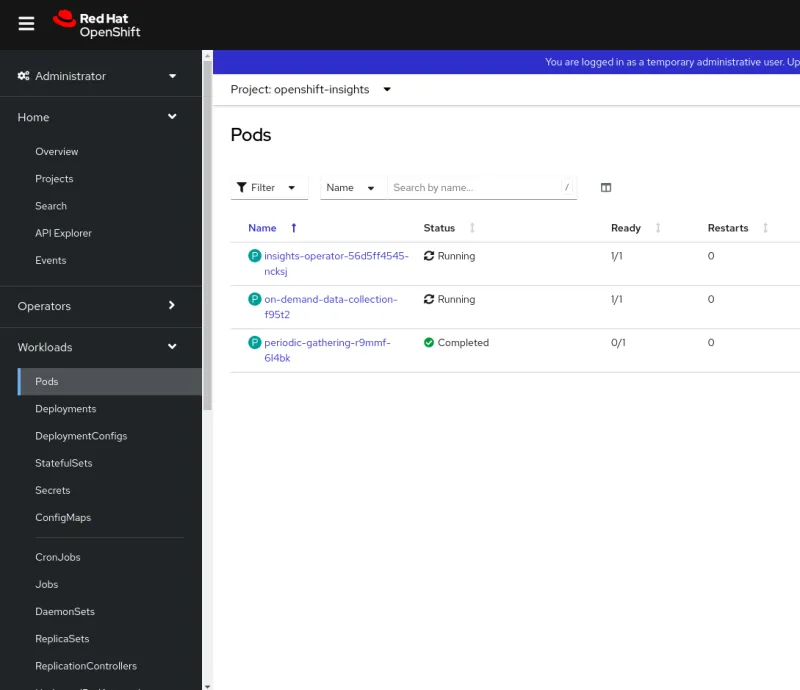Red Hat Insights Advisor for Red Hat OpenShift, as an integral part of the Red Hat Hybrid Cloud Console, provides cluster-wide Insights recommendations—steps to proactively avoid potential issues on your clusters or help resolve existing ones. These recommendations are based on analytical data from the OpenShift clusters, and one of the components responsible for this data delivery is the Insights Operator. (See the Remote Health Monitoring chapter in the OpenShift documentation for more details.)
Insights Operator packages and sends data from the OpenShift cluster every two hours. This delay can be inconvenient when Insights makes recommendations, and you must confirm that you successfully addressed them. Waiting for up to two hours can be tedious, which is why we introduced the new on-demand data collection feature as a technology preview in OpenShift 4.14.
This new feature is centered around a new CustomResourceDefinition (CRD) datagathers.insights.openshift.io/v1alpha1. You can see the CRD and its instances under the CustomResourceDefinitions in the Administration menu:

Instances of the CRD may already exist because a new instance of the DataGather resource is created each time the operator collects data. Note that these instances have the prefix periodic-gathering.
You can create your own instance of this resource by clicking the Create DataGather button. You must provide a unique resource name (i.e., there must be no resource with this name, for example, on-demand-collection-1). It looks like this:

Creating a new DataGather resource is how you trigger a new Insights on-demand data collection. You can create the resource with the OpenShift command line interface using the following YAML definition:
apiVersion: insights.openshift.io/v1alpha1
kind: DataGather
metadata:
name: on-demand-data-collection
spec:
gatherers:
- name: workloads
state: Disabled
To confirm that you have entered the right values, you should see a new Pod in the openshift-insights namespace with the same name as the newly created resource:

This Pod now runs a new data collection. Once finished, it uploads the data archive to Red Hat and checks if it was successfully processed. You can check the DataGather resource conditions on its Details page:

Once the gathering Pod completes successfully, the operator downloads new Insights analysis results. You will see the most recent Insights analysis result in the Insights status widget on the OpenShift WebConsole overview page. You can also check the insightsoperators.operators.openshift.io cluster resource, which provides information on active Insights recommendations:

What should you do?
We recommend using the on-demand gathering feature to validate critical recommendations and their remediations. This approach can help confirm your clusters are in the most optimized state and that you have mitigated potential or existing high severity issues.
Please note that this feature is currently in technology preview. As such, we are always looking for additional use cases and welcome any feedback that can help improve it. Please send your suggestions to insights@redhat.com.
Learn more
저자 소개
Tomas works in the Observability team for Red Hat OpenShift and focuses on data collection in OpenShift clusters and related operators.
유사한 검색 결과
Data-driven automation with Red Hat Ansible Automation Platform
Ford's keyless strategy for managing 200+ Red Hat OpenShift clusters
Technically Speaking | Platform engineering for AI agents
Technically Speaking | Driving healthcare discoveries with AI
채널별 검색
오토메이션
기술, 팀, 인프라를 위한 IT 자동화 최신 동향
인공지능
고객이 어디서나 AI 워크로드를 실행할 수 있도록 지원하는 플랫폼 업데이트
오픈 하이브리드 클라우드
하이브리드 클라우드로 더욱 유연한 미래를 구축하는 방법을 알아보세요
보안
환경과 기술 전반에 걸쳐 리스크를 감소하는 방법에 대한 최신 정보
엣지 컴퓨팅
엣지에서의 운영을 단순화하는 플랫폼 업데이트
인프라
세계적으로 인정받은 기업용 Linux 플랫폼에 대한 최신 정보
애플리케이션
복잡한 애플리케이션에 대한 솔루션 더 보기
가상화
온프레미스와 클라우드 환경에서 워크로드를 유연하게 운영하기 위한 엔터프라이즈 가상화의 미래
